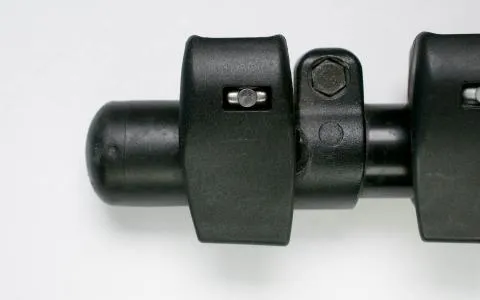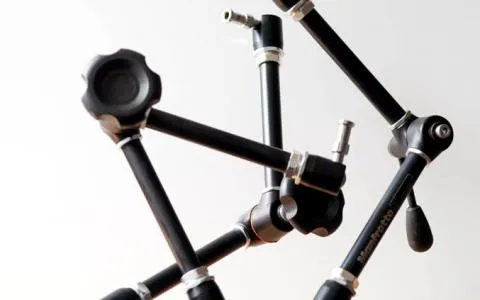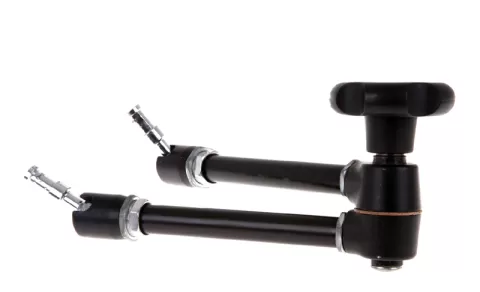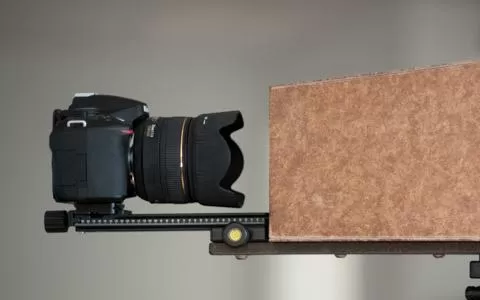I consider a good tripod an essential piece of photographic gear, and the way I take pictures I wouldn't be able to work for long without one.
I use a sturdy support for my cameras a lot of the time. I like shooting in the dark, I do a lot of tethered studio shooting and I even do a portrait series now and then, and in many cases I prefer having the camera on a tripod for stability, consistency and for having my hands free.
Aluminum and carbon
Tripods come in two basic flavors: aluminum and carbon. OK, there's also wood, but that's pretty exotic. I have a Manfrotto aluminum tripod and a Gitzo carbon tripod and they both work very well. The Manfrotto probably weighs about twice what the Gitzo weighs, and that is the exact reason why people buy carbon: weight. According to my experience the stability is about the same and facilities are what they are and can be the exact same between two tripods, one in metal and one in carbon.
The really big difference is price. Carbon is more expensive – like in twice the price of aluminum at least. And since a good tripod is already pretty expensive, a carbon tripod is very expensive. Add to that a good ballhead, and you are really bleeding.
Carbon is nice, but honestly: unless you need to carry it, save the money and spend it on a good ballhead in stead.
A good rule of thumb for tripods is a variation of a classic: Sturdy, light, cheap - pick any two.
Sturdy, light, cheap - pick any two.
Here's a few things I have gone for in tripods:
Don't skimp
First of all I warn against the low price ones. They are typically light, skinny, flimsy aluminum tripods with integrated plastic pan and tilt heads. Some people love them, but I deplore them and thinking that 40 or even 20 US$ can buy you a decent tripod is like thinking that you can get a great camera for the same price. It simply doesn't work like that. I'd say that barely decent tripods cost from about 150.- or 200.- US$ and up. Good ones typically cost 3-4-500 US$.
Good ballhead
I go for a separate, quality ballhead with a large ball, really good mechanics and a high load limit. It might cost the same as the tripod itself, but it's worth it. I have a Markins and an Acratech and love both. I also have a couple of cheapo no-name ballheads, which are OK, but not more than that. I'm not much for panorama heads. I have an oil dampened Giottos head that I bought for video work, but for stills I use a ballhead that can lock down any camera and lens that I can offer it.
The head must have an Arca-Swiss standard clamp. The Manfrotto clamps and plates are on the flimsy side and non-standard. Other manufacturers have even worse systems, plasticky and wobbly. The Arca-Swiss system is supported by dozens of manufacturers and can hold a lot of weight.
High enough
I want a tripod that elevates high enough to be at eye level without extending the center column – at least not too much. A bit will work, but too much and you get wobble. A tripod really can't be too high. You can always leave the thinnest leg section unextended, which will make it lower – and sturdier too. And when you need the height you will appreciate it.
Separate legs
I want the legs to be able to work separately and lock in any angle. Independent legs enable me to set up the tripod on almost any surface, even with wildly different heights and lengths for each leg. And being able to spread out the legs fully will let me get very close to the ground. So tripods with connections from the center column to the legs are out in my case.
Flexible
I like a center column that can be turned to a horizontal position. Both my tripods have this feature, and I use it a lot. It lets me bring the camera off center to the tripod, over a table or a ledge. Some people might not need this or even care, but I do. Other tripods have center columns that can be taken apart to shorten them while others again can be equipped with a shorter replacement center column, which you will mostly have to buy separately.
Locks
Most tripod legs are simple telescopic tubes that can lock in any position. Some use levers others use a revolving collar.
I have one of each and really have no preference as long as the locking is positive and firm and doesn't require excessive force to operate. On my Manfrotto the basic tension can be set to let the legs run freely, and collapsing the tripod is just a question of turning it upside down and letting the legs drop. The Gitzo slides with a bit of friction, but still works very smoothly.
The number of sections in the legs combined with the height of the extended tripod decides how compact it can be packed. I have one three section (the aluminum Manfrotto) and one four section (the carbon Gitzo), and the Gitzo packs significantly smaller than the Manfrotto, which is an advantage when carrying it or traveling. You can get tripods with six and even more sections that pack even smaller. But more sections also means more weight and more work to extend and collapse.
Some tripods have really smart central locks that can magically lock and unlock all legs at once. It's really smart but also expensive and probably vulnerable too. Such intricate mechanisms often are. I prefer simple and reliable.
When do you need a tripod?
Personally I use it for several purposes:
- For stability at long shutter speeds
- For stability and holding weight at long focal lengths
- For consistency and convenience when shooting in a studio
- For group shots - sometimes with myself in them
Shutter speeds
The shutter speed issue is of course pretty obvious. You simply can't hold the camera steady enough when the shutter speeds get long enough. You will shake the camera and get blurred images. The rule of thumb says that you can handhold a shutter speed of about 1/focal-lengths seconds. In other words: a 200mm requires at least 1/200th to be handheld while a 24mm can be held at 1/25th.
In my experience the rule isn't quite as simple. When using wideangles you can generally handhold fairly long shutter speeds, and I usually don't worry until I get over 1/15th or so when using 50mm, 35mm or wider. A deep breath, steady hands and the risk of shaking the short focal lengths is not great. I often shoot 2-3 images in fast succession to get the initial shake out of the way.
On the other hand I prefer 1/250th (or flash) for my 85mm and preferably 1/1000th or faster for my 70-200 at 200mm or for longer telephoto lenses like 300, 400 and 500mm lenses.
The tripod won't totally eliminate shake on long lenses, but with a few tricks they can become very stable.
Long lenses
When using really long lenses it can be both necessary and nice to use a tripod - both to hold the gear, which is typically heavy and to hold the thing stable, which isn't easy handheld.
When pro grade 35mm format lenses break the 2-300mm barrier they become large and heavy, and some kind of support becomes handy bordering on necessary. The smaller lenses like a 70-200 f/2.8 or a 300mm f/4 or even f/2.8 can be handled with a foot on a lens collar, but once you break into the 400mm and 500mm realm a gimbal becomes a really nice accessory. The gimbal turns the balance of the heavy gear from tipping on the top of a ball head to hanging in balance from a kind of swing, meaning that it's in balance even when you let go.
Gimbals match the lenses and the tripods when it comes to price, and once you go down that path, expect to part with quite a bit of money to get the full setup. A 500 dollar tripod, a gimbal at a similar price and then topped with a lens in the 10-20,000 dollar range...
Night photos
I have always liked shooting at night, and the ability for the camera to stay open for a long time, enables me to capture some scenes in a manner that can't even be seen with the eyes.
Night shots often call for 10, 20 and 30 seconds of open shutter time, and depending on lens and aperture, the shutter speeds can drop to minutes.
When the shutter is open that long, it's essentially just a question of keeping your hands off the gear while exposing. Unless it's very windy or the surface under you is very shaky, simply pressing the shutter and leaving the camera will usually give you sharp shots.
You can stabilize the tripod by hanging something heavy on it. I often hook my backpack under the center column for really long exposures or windy conditions. Some tripods even come with a hook for this purpose, but a heavy duty carabiner can do the trick. If your tripod doesn't allow for this, consider acquiring a so called stone bag, which hangs between the legs of the tripod and is loaded with stones or other heavy objects and can give a significant increase in stability.
The critical phase
There's a critical shutter speed interval even when using a tripod, and that's when the shutter speed is from a couple seconds down to about 1/30th or 1/60th. In this range any movement may be visible as blur in the image, and even the mirror clapping or you letting go of the shutter button will shake the camera enough for it to be visible. Since the shutter is open long enough for the shake to register but not long enough for the camera to become steady and the majority of the exposure to take place while it is, the images are prone to become blurred when shooting at these speeds.
The potential shake can be fought in different ways.
You can further stabilize the camera by leaning heavily on it. Cup a hand and an arm over the camera and lean hard on it while it exposes – of course keeping perfectly still. That dampens most shake.
Use a remote trigger to ensure that you don't push the camera while pressing the shutter. You can also use delayed exposure for a couple of seconds from you press the shutter – or use the 10-15 second self timer that is found on most cameras.
The more advanced SLR's have a mirror-up function, which will lift the mirror at first shutter press and release the shutter at the second, isolating the exposure from the shake induced by the mirror clapping. As soon as the shutter speeds get longer than 4-5 seconds, the influence of this initial camera shake diminishes and you just need to keep the camera still during the majority of the exposure to get a sharp shot.
Studio or static setup
When shooting a static setup or even shooting people in a studio environment, I often like to use a tripod.
When doing tabletop style photos or still lifes it keeps my hands free to manipulate the stuff I shoot. I mostly tether the camera and trigger it either using the computer or a wireless remote trigger.
With larger setups, shooting people or larger subjects, I like to be able to leave the camera and arrange lights, models or other things and the return to shooting. I sometimes use a remote trigger, sometimes just press the shutter button and sometimes take the camera off the tripod to shoot more freely.
Using wireless flash triggers and a clamp and plate for the camera, I can quickly remove the camera from the tripod and shoot handheld if I want.

![About 190 USD give you this fine Mefoto tripod with a good ballhead [Mefoto photo] About 190 USD give you this fine Mefoto tripod with a good ballhead [Mefoto photo]](/image.php?size=h327&file=https://500th.net/sites/default/files/mepfoto_a1350_0.jpg)
![Too cheap to be true? At 40 USD this Ravelli tripod probably is... [Ravelli photo] Too cheap to be true? At 40 USD this Ravelli tripod probably is... [Ravelli photo]](/image.php?size=h327&file=https://500th.net/sites/default/files/ravelli_apgl5.jpg)
![Going low requires legs than spread wide - mine as well as on thr tripod [Henning Eskol photo]](/image.php?size=w600&file=https://500th.net/sites/default/files/low.jpg)




![A stone bag [Vanguard photo] A stone bag [Vanguard photo]](/image.php?size=h331&file=https://500th.net/sites/default/files/vanguard-sone-bag.jpg)
![Large lenses require sturdy tripods - and preferably a gimbal [Jan-Ole Willers photo]](/image.php?size=w600&file=https://500th.net/sites/default/files/gimbal.jpg)







